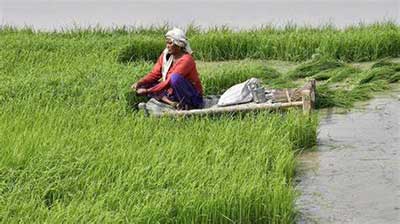Date: 22/02/2023
Relevance: GS-3: Inclusive growth and issues arising from it,Government Budgeting
Key Phrases: Nationally Determined Contribution (NDC), Amrit Dharohar, PM PRANAM, GOBARdhan, MISHTI, Agriculture Accelerator Fund, Green Credit programme.
Context:
- Coinciding with India’s G20 presidency, the identification of green growth as one of the seven core economic priorities showcases India’s commitment to a sustainable future.
What is Green Growth?
- Green growth means fostering economic growth and development while ensuring that natural assets continue to provide the resources and environmental services on which our well-being relies.
- To do this it must catalyse investment and innovation which will underpin sustained growth and give rise to new economic opportunities.
What Does It Aim to Achieve?
- Enhancing productivity by creating incentives for greater efficiency in the use of natural resources, reducing waste and energy consumption, unlocking opportunities for innovation and value creation, and allocating resources to the highest value use.
- Boosting investor confidence through greater predictability in how governments deal with major environmental issues.
- Opening up new markets by stimulating demand for green goods, services and technologies.
- Contributing to fiscal consolidation by mobilising revenues through green taxes and through the elimination of environmentally harmful subsidies. These measures can also help to generate or free up resources for anti poverty programmes in such areas as water supply and sanitation, or other pro-poor investments.
- Reducing risks of negative shocks to growth due to resource bottlenecks, as well as damaging and potentially irreversible environmental impacts.
How Government is Ensuring Green Growth?
- The finance minister listed “green growth” among four opportunities that can be transformative for India in the run up to 2047, the country’s 100th year of independence.
- The other three are:
- economic empowerment of women,
- integrating traditional artisans with the MSME sector,
- and tourism.
- Nationally Determined Contribution (NDC):
- India formally updated its nationally determined contribution (NDC) to fight climate change, confirming to the United Nations Framework Convention on Climate Change last August that it will reduce the emissions intensity of its Gross Domestic Product (GDP) by 45% from 2005 levels by the year 2030, and source about 50% of its energy requirement from non-fossil fuel-based sources the same deadline.
- PM PRANAM:
- Programme for Restoration, Awareness, Nourishment and Amelioration of Mother Earth, a scheme that will be launched to incentivise states and union territories to promote alternative fertilizers and balanced use of chemical fertilizers.
- GOBARdhan (Galvanizing Organic Bio-Agro Resources Dhan):
- Around 500 new ‘waste to wealth’ plants will be launched under GOBARdhan (Galvanizing Organic Bio-Agro Resources Dhan) for promoting circular economy.
- These will include 200 compressed biogas (CBG) plants at total investment of ₹10,000 crore.
- In due course, a 5% CBG mandate will be introduced for all organizations marketing natural and bio gas.
- For collection of bio-mass and distribution of bio-manure, appropriate fiscal support will be provided.
- MISHTI (Mangrove Initiative for Shoreline Habitats & Tangible
Incomes):
- It will focus on mangrove plantations along the coastline and on salt pans through convergence between Mahatma Gandhi National Rural Employment Guarantee Scheme (MGNREGS) and Compensatory Afforestation funds.
- Amrit Dharohar :
- Government will promote conservation techniques of local communities through Amrit Dharohar, a scheme that will be implemented over the next three years to encourage optimal use of wetlands, and enhance bio diversity, carbon stock, eco-tourism opportunities and income generation for local communities.
- Coastal shipping will be promoted as an energy efficient mode of transport through PPP mode with viability gap funding.
- Agriculture Accelerator Fund:
- The Agriculture Accelerator Fund announced in the Budget will provide crucial funding for entrepreneurs to drive innovation.
- Green Credit programme:
- The Green Credit programme outlined in the Budget to incentivise behavioural change for people, organisations, and local bodies is encouraging.
- Energy Conservation Bill:
- The Energy Conservation Bill envisions the creation of a domestic carbon market, and coupled with the anticipated revival of UN-sanctioned international carbon trading, the government can not only stimulate India’s emergence as the world’s leading supplier of carbon offsets, but also provide overarching guidance to industries for their long-term decarbonization plans.
- Municipal Bonds or Muni Bonds:
- These have internationally proven to be successful tools for cities to raise funds for green infrastructure development.
- The success of Ghaziabad’s recent issuance of a Muni Bond for a waste plant and Indore’s Green Bond issuance shows the promise of green financing to build sustainable cities in India through this avenue.
Conclusion:
- Execution will be key, both in delivering on past commitments and in creating new opportunities for economic growth.
- The Sustainable Alternative towards Sustainable Transportation (SATAT) scheme, announced in 2018 to achieve 5,000 compressed biogas plants by 2023, has only met 1 percent of the target so far.
- And only around 60 percent of the 2022 target of 175GW of renewable energy was delivered.
- The Union Budget reflects the financial allocations for projects and initiatives framed as green or addressing climate change concerns.
- While this focus is important, it needs to be located within the understanding that these finances, once allocated will necessarily translate into specific projects including renewables, plantations or green manufacturing or linear infrastructure.
- Each of these sectoral investments requires careful examination on the ecological precautions and the social cost assessments which are elusive in both project design and implementation.
Source: The Hindu BL
Mains Question:
Q. What is Green Growth? How Government is ensuring Green Growth in India? (250 words).






















